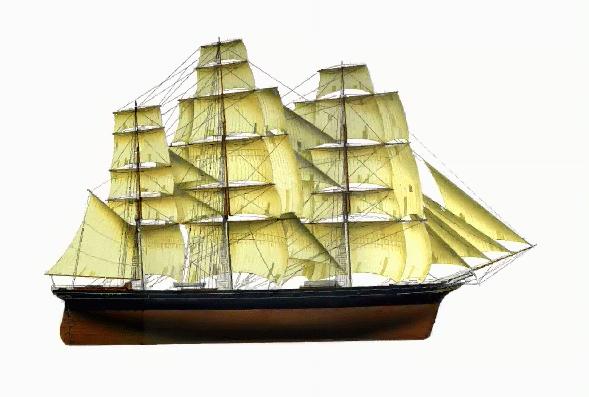

Clipper ships were exceptionally fast, graceful sailing ships. This type of vessel "moved at a good clip" and could "clip" time from long ocean voyages, hence its name. The first clippers were wooden schooners built in Virginia and Maryland and were known as Baltimore clippers. Having first gained fame as blockade runners and privateers during the War of 1812, these schooners later earned notoriety as West African slave ships. They were not, however, true clippers. The first true clipper was the Rainbow, built at New York in 1845. Typical dimensions were a length of 64.6 m (212 ft) and a beam of 6.4 m (21 ft). They had a raked stem, a counter stern, and were ship-rigged (with the largest possible sail plan). The first clippers had wooden hulls; later ships had composite hulls (iron frames with wood used elsewhere). Clippers were designed for maximum speed, and were initially used for transportation to and from the gold rushes of California (1848) and Australia (early 1850s). Best known were the Flying Cloud and the Flying Fish, built by Donald Mackay of Boston, and the Sovereign of the Seas, which sailed across the Atlantic in less than 14 days. Clippers were so fast, in fact, that the 1854 record set by the Flying Cloud--89 days from New York to California via Cape Horn--was broken only in 1989 by a modern yacht incorporating the most advanced sail technology.
When British firms began ordering U.S. clipper ships for the China tea trade, Scotland's shipyards were spurred to design their own clippers. The high prices obtained in London for the first of each season's tea crop led to races from China to Britain. Leaving Foochow between May 29 and May 31, 1866, the Fiery Cross, Ariel, Taeping, Taitsing, and Serica all reached London between Sept. 6 and Sept. 8; the Serica completed the 25,744-km (16,000-mi) voyage in less than 100 days. Another famous race took place between the Thermopylae and the Cutty Sark in 1868; the latter was leading by 643 km (400 mi) until she lost her rudder in a gale in the southern Indian Ocean.
The American Civil War (1861-65) had disastrous consequences for U.S. shipbuilders, who were no longer able to compete with British shipyards. Then, in 1869, the opening of the Suez Canal deprived British tea clippers of their handsome profits. For a time, clippers were used in the Australian wool trade, but they were unable to compete with much larger, but slower, four- and five-masted sailing ships.
The Cutty Sark has been preserved in dry dock as a museum at Greenwich, England. CAPT. GEOFFREY BENNETT, ROYAL NAVY (RET.)
[The Academic American Encyclopedia (1995 Grolier Multimedia Encyclopedia Version), copyright (c) 1995 Grolier, Inc. Danbury, CT.]
| PREV | Bridge | NEXT |
|---|